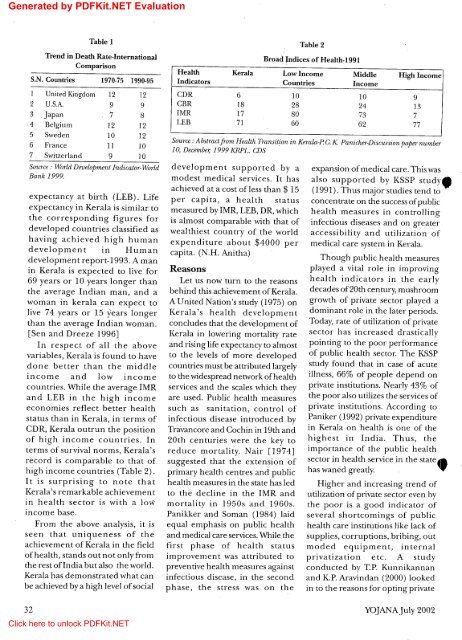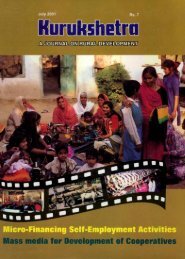Banking - Yojana
Banking - Yojana
Banking - Yojana
- TAGS
- banking
- yojana
- yojana.gov.in
Create successful ePaper yourself
Turn your PDF publications into a flip-book with our unique Google optimized e-Paper software.
Generated by PDFKit.NET Evaluation<br />
Table I<br />
Trend in Death Rate-International<br />
Comparison<br />
S.N. Countries 1970-75 1990-95<br />
United Kingdom 12 12<br />
2 U.S.A. 9 9<br />
3 Japan 7 8<br />
4 Belgium 12 12<br />
5 Sweden 10 12<br />
6 France II 10<br />
7 Switzerland 9 10<br />
Source: World Development Indicator- World<br />
Bank 1999.<br />
expectancy at birth (LEB). Life<br />
expectancy in Kerala is similar to<br />
the corresponding figures for<br />
developed countries classified as<br />
having achieved high human<br />
developmen t in Human<br />
development report-1993. A man<br />
in Kerala is expected to live for<br />
69 years or 10 years longer than<br />
the average Indian man, and a<br />
woman in kerala can expect to<br />
live 74 years or 15 years longer<br />
than the average Indian woman.<br />
[Sen and Dreeze 1996]<br />
In respect of all the above<br />
variables, Kerala is found to have<br />
done better than the middle<br />
income and low income<br />
countries. While the average IMR<br />
and LEB in the high income<br />
economies reflect better health<br />
status than in Kerala, in terms of<br />
CDR, Kerala outrun the position<br />
of high income countries. In<br />
terms of survival norms, Kerala's<br />
record is comparable to that of<br />
high income countries (Table 2).<br />
It is surprising to note that<br />
Kerala's remarkable achievement<br />
in health sector is with a low<br />
income base.<br />
From the above analysis, it is<br />
seen that uniqueness of the<br />
achievement of Kerala in the field<br />
of health, stands out not only from<br />
the rest ofIndia but also the world.<br />
Kerala has demonstrated what can<br />
be achieved by a high level of social<br />
32<br />
Click here to unlock PDFKit.NET<br />
Table 2<br />
Broad Jndices of Health-I 991<br />
Health Kerala Low Income Middle High Income<br />
Indicators Countries Income<br />
CDR 6 10 10 9<br />
CBR 18 28 24 13<br />
IMR 17 80 73 7<br />
LEB 71 60 62 77<br />
Source: Abstract from Healt/; Transition in Kemla-P. G. K. Panicker-Discussion 1mper number<br />
10, December, 1999 KRPL. CDS<br />
development supported by a<br />
modest medical services. It has<br />
achieved at a cost ofless than $ 15<br />
per capita, a health status<br />
measured by IMR, LEB, DR, which<br />
is almost comparable with that of<br />
wealthiest country of the world<br />
expenditure about $4000 per<br />
capita. (N.H. Anitha)<br />
Reasons<br />
Let us now turn to the reasons<br />
behind this achievement of Kerala.<br />
A United Nation's study (1975) on<br />
Kerala's health development<br />
concludes that the development of<br />
Kerala in lowering mortality rate<br />
and rising life expectancy to almost<br />
to the levels of more developed<br />
countries must be attributed largely<br />
to the widespread network of health<br />
services and the scales which they<br />
are used. Public health measures<br />
such as sanitation, control of<br />
infectious disease introduced by<br />
Travancore and Cochin in 19th and<br />
20th centuries were the key to<br />
reduce mortality Nair [1974]<br />
suggested that the extension of<br />
primary health centres and public<br />
health measures in the state has led<br />
to the decline in the IMR and<br />
mortality in 1950s and 1960s.<br />
Panikker and Soman (1984) laid<br />
equal emphasis on public health<br />
and medical care services. While the<br />
first phase of health status<br />
improvement was attributed to<br />
preventive health measures against<br />
infectious disease, in the second<br />
phase, the stress was on the<br />
expansion of medical care. This was<br />
also supported by KSSP study'<br />
(1991). Thus major studies tend to<br />
concentrate on the success of public<br />
health measures in controlling<br />
infectious diseases and on greater<br />
accessibility and utilization of<br />
medical care system in Kerala.<br />
Though public health measures<br />
played a vital role in improving<br />
health indicators in the early<br />
decades of 20th century, mushroom<br />
growth of private sector played a<br />
dominant role in the later periods.<br />
Today, rate of utilization of private<br />
sector has increased drastically<br />
pointing to the poor performance<br />
of public health sector. The KSSP<br />
study found that in case of acute<br />
illness, 66% of people depend on<br />
private institutions. Nearly 43% of<br />
the poor also utilizes the services of<br />
private institutions. According to<br />
Paniker (1992) private expenditure<br />
in Kerala on health is one of the<br />
highest in India. Thus, the<br />
importance of the public health<br />
sector in health service in the state,<br />
has waned greatly.<br />
Higher and increasing trend of<br />
utilization of private sector even by<br />
the poor is a good indicator of<br />
several shortcomings of public<br />
health care institutions like lack of<br />
supplies, corruptions, bribing, out<br />
moded equipment, internal<br />
privatization etc. A study<br />
conducted by T.P. Kunnikannan<br />
and K.P. Aravindan (2000) looked<br />
in to the reasons for opting private<br />
YOJANAJuly 2002






